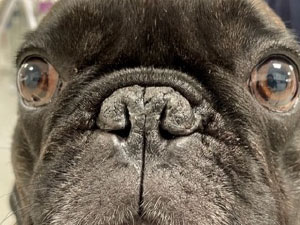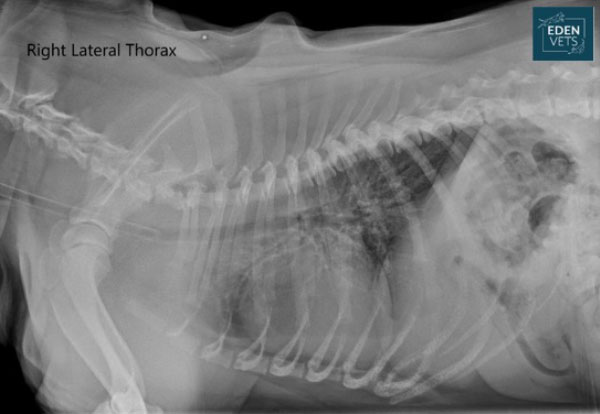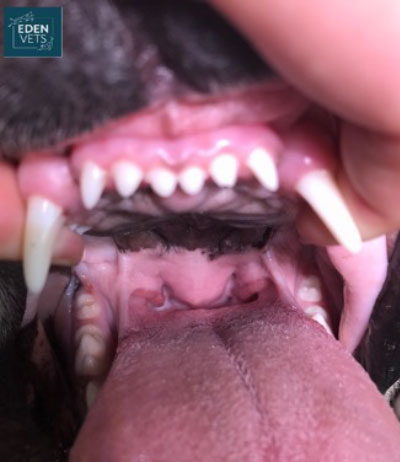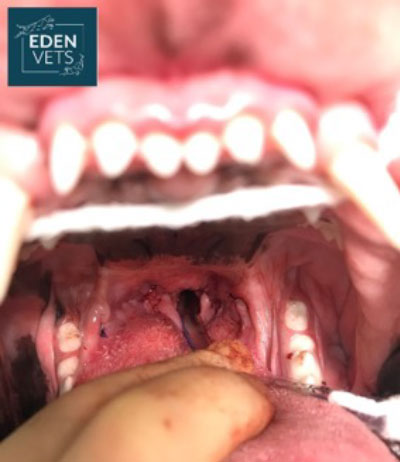Brachycephalic Obstructive Airway Syndrome
‘Brachycephalic’ means ‘short headed’.
The French bulldog, British bulldog, Pug, Pekingese, shih tzu, Japanese chin, boxer and Boston terrier are all examples of brachycephalic breeds. The most distinctive feature of these breeds is their short muzzle.
In recent decades, breeding selection for extreme brachycephalic features has resulted in dogs that are predisposed to upper airway tract obstruction and subsequent respiratory distress, among several other health issues. Although not all brachycephalic dogs show clinical signs, the incidence and severity of the respiratory disorders has increased. The respiratory disease related to brachycephalic confirmation is called brachycephalic obstructive airway syndrome (BOAS). Recent research has shown that the condition occurs in 40% British bulldogs, 45% in French bulldogs and 60% of Pugs.
In brachycephalic dogs, while the length of the skeletal muzzle is reduced, there is often no corresponding decrease in the size of the soft tissue contained in the skull. This results in a constricted effect within the nasal cavity and partial obstruction of the pharynx and larynx.

BOAS is the result of multiple factors acting together to cause obstruction to air flow into the lungs.
Primary factors (present from a very young age and related to the head shape):
- Stenotic nares (narrow nostrils)
- Aberrant nasal turbinates
- Overcrowded turbinates
- Elongated, thick, soft palate
- Laryngeal collapse (Pugs only)
Secondary factors (progressive deteriorations to the airway resulting from the abnormal forces present during breathing):
- Mucosal hypertrophy
- Laryngeal collapse
- Tonsillar hypertrophy / eversion
- Gastro-intestinal signs (regurgitation, acid reflux, vomiting, hypersalivation)

The signs of BOAS are varied and can range in severity, including some or all of the following:
- Respiratory noise:
- Snorting or snoring at rest of during exercise
- Reduced or poor exercise tolerance
- Difficulty breathing either at rest of during exercise
- Prolonged recovery after exercise
- Stenosis of the nostrils
- Gastrointestinal signs
- Retching, regurgitation, and vomiting
- Obstructive sleep apnoea / sleep-disordered breathing
- Heat intolerance
- Cyanosis (discoloured/purple gum colour) and Collapse (due to lack of air).
You should consider seeking veterinary advice if you have noticed any of the clinical signs outlined above.
What Treatments are Available?
Diagnostic tests:
BOAS clinical signs may not be present at rest in some moderately affected dogs. Therefore, alongside a clinical examination by our vets, functional grading based on a 3-minute trotting exercise tolerance test is also suggested. There are four BOAS reference grades.
- Grade 0 and I are considered clinically unaffected.
- Grades II and III are considered clinically BOAS-affected and they require management and/or treatment.
Head/neck and thoracic radiography or CT scans are part of the diagnostic workup for BOAS. Thoracic radiography/CT scans can assist in the diagnosis of tracheal/bronchial hypoplasia/collapse, oesophageal diverticula, hiatal hernia, and aspiration pneumonia. Head/neck CT scans can provide guidance for the planning of surgical techniques such as folded flap palatoplasty, alar fold resection, and turbinectomy.
Pharyngeal, laryngeal, and nasal cavity lesions can be assessed via laryngoscopy/endoscopy under sedation or general anaesthesia. Rhinoscopy is particularly helpful for assessing nasal obstruction.

Management and Surgical treatment:
Fitness
- Comparing body weight to the breed average weight is not a reliable way to assess a dog’s ideal weight. Body condition score (BCS) is a more useful scoring system to assess whether an animal is underweight or overweight. Standard BCS scale is 1-9 with 1 being too thin and 9 being obese.
- Research findings show that obesity (i.e. BCS≥7) is significantly associated with BOAS. Fat tissue within the airway tract can further narrow the lumen. For obese dogs with mild to moderate BOAS signs, weight loss is suggested prior to surgical intervention.
Prevention of heat stress
- While it is important that you exercise your dog regularly and keep him/her fit, it is also important to remember that brachycephalic breeds, particularly BOAS-affected dogs, may have difficulty regulating their body temperature. Therefore, it is recommended that you avoid exercising your dog excessively or during hot summer days.
- In general, it is best to keep your dog away from hot environments or situations that may cause too much excitement or stress in him/her.
- Signs of overheating include heavy panting, elevated body temperature, glazed eyes, increased pulse, vomiting/diarrhoea, excessive thirst, dark red tongue, excessive drooling, staggering. In severe cases, they may seizure, collapse, become unconsciousness, or even die.
- If you notice signs of overheating in your dog, you should move him/her to a cool place with good air conditioning. You should keep providing him/her with a small amount of water to drink to avoid dehydration and cool him/her down by soaking with cool water. Contact your vet for further treatment and evaluation.
Medication
Surgical intervention:
BOAS surgery aims to improve air flow through a fundamentally compromised upper airway. Unfortunately, it is not possible to correct all the challenges faced by these dogs, as such they remain compromised to varying degrees despite the appropriate airway surgery having been performed.
Surgical interventions are as follows.
Pharynx
Shortening of elongated soft palate and tonsillectomy.
Larynx (laryngeal saccules and cartilages)
• Removal of everted laryngeal saccules and assessment of laryngeal cartilages.
• Laryngeal collapse (associated with Pugs) is a secondary disorder related to progressive deterioration to the largyneal cartilages due to excessive pressures during breathing. It is a difficult condition to treat but salvage procedures such as larynoplasty and laryngeal lateralistion (‘tie-back’) can be employed for grade II and III.
Nostrils (external nostril wings and alar folds)
Rhinoplasty to widen the nostrils.
Nasal cavity (nasal turbinates)
Laser-assisted turbinectomy (LATE) has been used to address the intranasal obstruction, particularly in pugs and French bulldogs. This procedure is performed at specialist referral centres only.


Expectations after Surgery:
Post-operative recovery from anaesthetic is the major risk related to the surgery. Inflammation and swelling of the airway may occur post-operatively. A temporary tracheostomy tube can be placed if necessary. Aspiration pneumonia caused by regurgitation is also a risk after surgery. Gastro-protectants are given to all surgical patients. Complications can vary in severity. Most are relatively minor and improve in time, however some can be more serious. The surgical team will keep you informed as often as required regarding any concerns they have about your pet. Most patients do not suffer any significant issues and are able to return home the day after surgery.
The aim of the surgery is to dramatically improve the dog’s ability to breathe by reducing the resistance to air in the airway. The extent of this improvement is variable due to BOAS being a multifactorial condition, but many dogs will show a significant improvement to their ease of breathing and their ability to exercise. It can take several weeks after the surgery before the full extent of improvements can be seen.
The surgical results are variable and depend on the severity of the disease. Dogs with Grade II or III laryngeal collapse usually have a poorer prognosis. BOAS is not curable. Nevertheless, upper airway corrective surgery can provide a better quality of life and it is hoped that surgery will slow the progression of laryngeal collapse. Revision surgery might be required in some severely affected dogs. Regular post-operative checks with your vet are recommended.
For further information about BOAS including videos and images about the condition please visit the BOAS research group at Cambridge university; www.vet.cam.ac.uk/boas/about-boas
